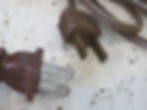How to Identify Antique & Vintage Lamps: Austin’s Guide to Glowing Good Taste
- Beau Sutton
- 2 days ago
- 3 min read

💡 Let’s Talk Lamps — Austin Style
At Side Kitsch Vintage, we’ve seen it all — from glamorous mid-century floor lamps that look straight out of Mad Men to ornate art deco beauties that once lit up 1920s parlors. Lamps are one of our favorite finds because they blend style, history, and function — and when you learn what to look for, you can spot a real-deal antique in no time.
So, if you’ve ever picked up a lamp at a flea market and wondered “Is this thing actually vintage?” — here’s your field guide to figuring it out.

🔌 1. Start with the Plug: A Bright Clue from the Past
Look closely at the plug and cord — they’re like fingerprints for age.
If both prongs on your plug are the same size, your lamp likely dates before the 1980s, when safety rules changed to require one larger neutral prong.
Now check the cord material:
🧵 Cloth-wrapped: 1920s–40s
🧽 Rubber or plastic: 1950s
✨ Clear vinyl: 1970s–80s
If you plan to use the lamp, have it professionally rewired — old cords can be a fire hazard, even if they look fine.

2. The Socket Story
Vintage sockets are usually metal — brass, copper, or nickel — and often have pull chains or turn keys. Modern ones are plastic and less ornate.
Look for brand names stamped on the socket, like Leviton, Bryant, or Eagle — all classic mid-century manufacturers that prove your lamp’s age and authenticity.

🪶 3. Style Speaks Volumes
Each lamp tells a design story:
Art Deco (1920s–30s): Chrome accents, stepped bases, and geometric flair.
Mid-Century Modern (1950s–60s): Sleek teak, tripod legs, and fiberglass shades.
Hollywood Regency (1940s–70s): Gold tones, glass prisms, pure glamour.
Arts & Crafts / Tiffany Era (early 1900s): Stained glass and nature motifs.
Even the shade can hint at age — fiberglass with gold threading screams mid-century, while silk or parchment shades point earlier.

🔩 4. Construction Clues
Peek under the base and around the screws. Flat-head screws were the standard until the 1940s — Phillips-head came later.
Older lamps were built with solid metal and glass, often showing natural patina (a beautiful aged tone). Keep that patina — it’s part of your lamp’s charm!
🏷️ 5. The Maker’s Mark
Flip that lamp and check for foil stickers, embossed names, or stamped marks. These can confirm both maker and era.
Brands to look for include:
Tiffany Studios, Handel, Pairpoint (early 1900s)
Stiffel, Rembrandt, Frederick Cooper, Laurel Lamp Co. (mid-century)
A surviving label can increase the lamp’s collectible value — so handle with care!
🕰️ Final Glow-Up
Lamps are more than light sources — they’re time machines. Whether you’re restoring a 1930s table lamp or styling a mid-century modern corner, understanding these details helps you connect with design history.
So next time you’re at Side Kitsch Vintage or treasure-hunting across Austin, take a closer look at that old lamp — it might be holding a century of stories just waiting to shine again.
✨ Stay vintage, stay curious, and let your next find light up your life.
—🪩 Written by Side Kitsch Vintage & Scissor Sisters ATXWhere great hair meets great finds — Austin’s home for style, sass, and all things retro. www.atxvintage.com | @sidekitschvintage | @scissorsistersatx


